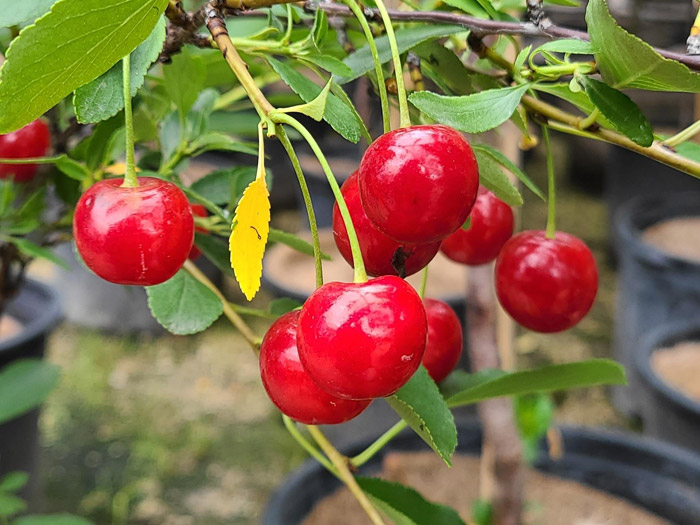Let’s talk about the pits, no not the holes in the roads or the rough patches of our lives, I’m talking about pitted fruits. And I want to start with a favorite, cherries! The Romance Cherries are an interesting family that is quite new to the market. These cherries are the result of crossbreeding Mongolian Cherries with European Cherries by Les Kerr. He ran a secret breeding program starting back sometime in the 1940s. He was supposed to be breeding only shelterbelt plants while working for the federal government in Manitoba as head of the Forestry Farm Shelterbelt Centre in Saskatoon. But he had a dream to create hardy sour cherries for the Prairie. To avoid attention, all the plants he crossbred and selected were planted at several farms belonging to his friends. For forty years he worked in secret on this project! When he was hospitalized toward the end of his life he told George Krahn of Lakeshore nursery about his secret project and George convinced him to donate the Cherries to the University of Saskatchewan breeding program. Les told them which farms to visit to find his best cherries. The university staff gathered fruit for seeds and cuttings which were grown at the University of Saskatchewan as well as Lakeshore nursery. From these selections we now have the varieties we are familiar with. Romeo, Juliet, Cupid, Valentine, Carmine Jewel and others. Now a third generation of these sour cherries is being released to the market including Cutie Pie, Sweet Thing and more! These cherries are self-fertile, not needing and not accepting pollination from any cherry variety in our area outside their own Romance Cherry family.
Red Nanking Cherries are a Manitoba classic. Native to central Asia, they were first introduced to North America in the 1880s. The fruit is smaller than in sour cherries but is sweeter and juicier. This makes them more ideal for fresh eating or canning as they can be messy in baking. They have a great cold tolerance and often begin to produce fruit at a younger age than Sour cherries. Pink Candles Nanking Cherry is a selection of Red Nanking with a bit more pink colour in their spring flowers. Black Nanking Cherry is actually a cross bred of the Red Nanking Cherry with the Sand Cherry. The fruit is large and tasteful, making it one of the better cherries for fresh eating in the prairies.
Sand Cherries are one of the few cherries that are native here… but is it actually a Cherry? The fruit size suggests it is, but there is more than one fruit with a pit at its center. According to our research the Sand Cherry is actually a Plum! A tiny variety of Plum that looks like a cherry. This explains why it helps pollinate Plum trees so well. The fruit itself is small, and dark purple/black. They are stringent in flavor, like Chokecherry but milder and are often used in preserves.
Chokecherry is also native here and can often be found growing in the woods. The fruit is small, black and quite stringent, leaving the mouth feeling dry or chalky. The flavour itself is not bad if you can get past the dryness, but most people use the fruit in preserves or wines. The Shubert Chokecherry was selected for its purple summer foliage. It was widespread and popular all across southern Canada for years until Black Knot disease broke out. A fungal infection that grows on the branches forming a crusty black lump on the branches. Very unappealing! With less and less Chokecherries being planted the disease has slowed in its spreading.
Pin Cherry is native and the fruit can be used to make excellent jam. The problem is that the fruit is very small, often only 1-2cm. It can be a lot of work and many people select to grow the tree simply for its beautiful flowers and to attract birds.
Amur Cherry, sometimes known as Amur Chokecherry, is once again from Asia and portions of Russia, Korea and China. The fruit is also edible and used in preserves, though some Amur Cherry varieties do not produce fruit. I do see a lot of similarity between our native Chokecherry and the Amur “chokecherry”. The unique bark, leaf shape, tiny fruit… I wonder if we could cross breed the two… An experiment for another day! Well I will call it there for today, stay tuned for part 2 which will cover our next favorite pitted fruit…plums!




